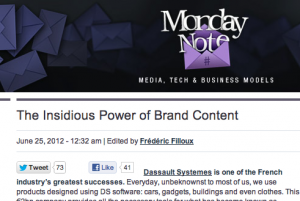Brands
How Insidious Is the Power of Brand Content? Some Reply, ‘Not at All’
Brand content and content marketing are swiftly replacing traditional methods of advertising. Concurrently, as brand content gains popularity, the news industry is suffering.
 Frédéric Filloux, general manager of the French ePresse consortium, started a lively debate this week when he wrote on the Monday Note blog that brand content is as manipulative as it is ubiquitous, and he suggests its underhanded method of influence raises ethical questions.
Frédéric Filloux, general manager of the French ePresse consortium, started a lively debate this week when he wrote on the Monday Note blog that brand content is as manipulative as it is ubiquitous, and he suggests its underhanded method of influence raises ethical questions.
A traditional advertisement has a visible return on investment (sales), fosters short-term exposure, and spotlights products and services front and center, Filloux says, whereas brand content keeps products and services mostly hidden and is not as honest about its intentions.
For example, a 30-second commercial spot for McDonald’s aims to increase sales by showing photos of a mouthwatering cheeseburger. Humorous videos by Old Spice will make customers laugh and stick in their brains when they shop. The McDonald’s scenario is the old method and the Old Spice campaign and similar campaigns are what all the marketers and companies are raving about.
It’s also been proven that traditional ads do not foster real engagement or long-lasting customer relationships. One of the biggest advantages of brand marketing is that it’s much cheaper than advertising.
The corruption of journalistic standards?
“The downfall of the print press has opened floodgates: publishers become less and less scrupulous in their blurring of the line between editorial and promotion — which is precisely what ad agencies always shoot for,” says Filloux. “Most women magazines, the luxury press, and now mainstream glossies allocate between 30% and 70% to such ‘tainted’ editorial: nice ‘journalistic’ treatment in exchange for favors on the advertising side.”
Filloux writes that growing relationships between marketers and reporters will only further the perception among many that the media is corrupt. It will also lead to readers being less informed about products.

Commenting on “The Story So Far,” a Columbia Journalism School report about the state of modern journalism, author Nathaniel Parish Flannery writes that it’s logical why newspapers are fraternizing with companies — to make up for the loss in ad space.
In his 2011 article, published in Forbes, he writes, “one major newspaper chain found that even though web traffic at its sites increased by almost 20% recently, digital ad revenue increased by barely 2% during the same period.”
Flannery adds, “Advertisers are now starting to realize that the web, like TV and print, can be used as a branding exercise, and not merely as a gimmick to try to pull in site visitors to ads for special offers or sales.”
Though the increased usage of branded journalism looks like it could lead to the end of the industry as people know it, Filloux may not be seeing the whole picture.
Raising marketing standards with journalistic practice
Kyle Monson, a marketer at J. Walter Thompson and former journalist, says that brand journalism actually supports transparency, honesty, and encourages companies to create better content.
“JWT has a team of editors and strategists with journalism and publishing backgrounds,” he says. “Other agencies and campaigns are hiring journalists as well. Together, we infiltrate big companies and convince them that it’s possible to work quickly and openly.”
Monson says that brand journalism a better way to market.
“Like journalists, we can create compelling content under extremely tight deadlines, and engage with communities in meaningful ways. Good and fast—that’s what we’re striving for with brand journalism,” Monson says.
“The marketing industry isn’t exactly known for creating good content quickly, but we’re working in a real-time world, and clients and agencies are realizing that they’re struggling to keep up,” he says. “Brand journalism can be a tool that helps them optimize for speed.”
Social Times’ Amanda Cosco doesn’t see the emergence of brand content as having a hugely negative impact on the news industry. She argues that people are upset over semantics — the fact that it’s called branded journalism, because it perhaps isn’t journalism.
“Would traditional reporters and journalists be happier if we called branded content just that, and avoid the label of ‘journalism,’ which is supposed to suggest a deeper, unperverted love for the truth?” she asks.
Brand content is targeted content
Cosco also highlights the fact that sponsoring content and commissioning works of art has been around at least since the days of Shakespeare. If branded content and “real” journalism and art could co-exist for hundreds of years, it won’t change any time soon.
“Nay-sayers worry that brand-sponsored stories will undermine journalism as we know it,” Cosco says. “These people fathom an Orwellian world where state powers shape the news to brainwash the nation. … What we have to keep in mind is that branded content isn’t interested in covering the news (political campaigns, crime stories, etc); instead, branded content is interested in reporting the stories relevant to that brand’s industry.”
From branded content can come great stories, conversations, and engaging information. The good news is that the new emphasis on providing compelling content forces companies to be more communicative and raise their advertising standards.
Cosco says, “In a world awash with poor marketing and loud advertising, we need better stories today more than ever.”
Image courtesy of kentoh/shutterstock

Get better at your job right now.
Read our monthly newsletter to master content marketing. It’s made for marketers, creators, and everyone in between.




